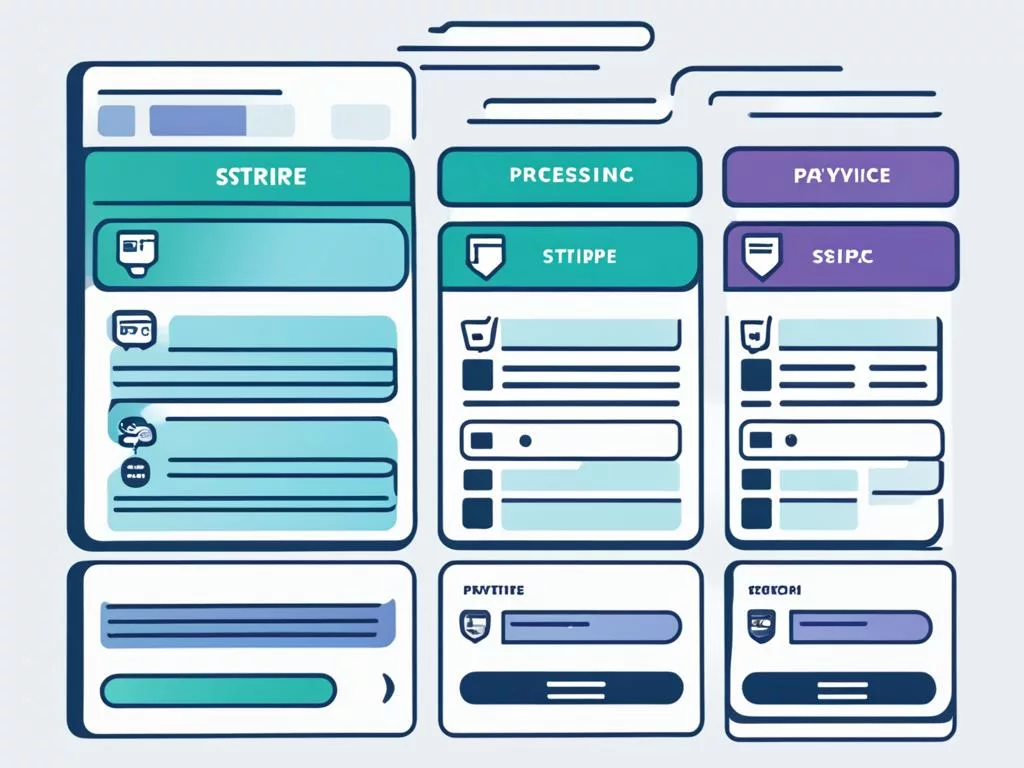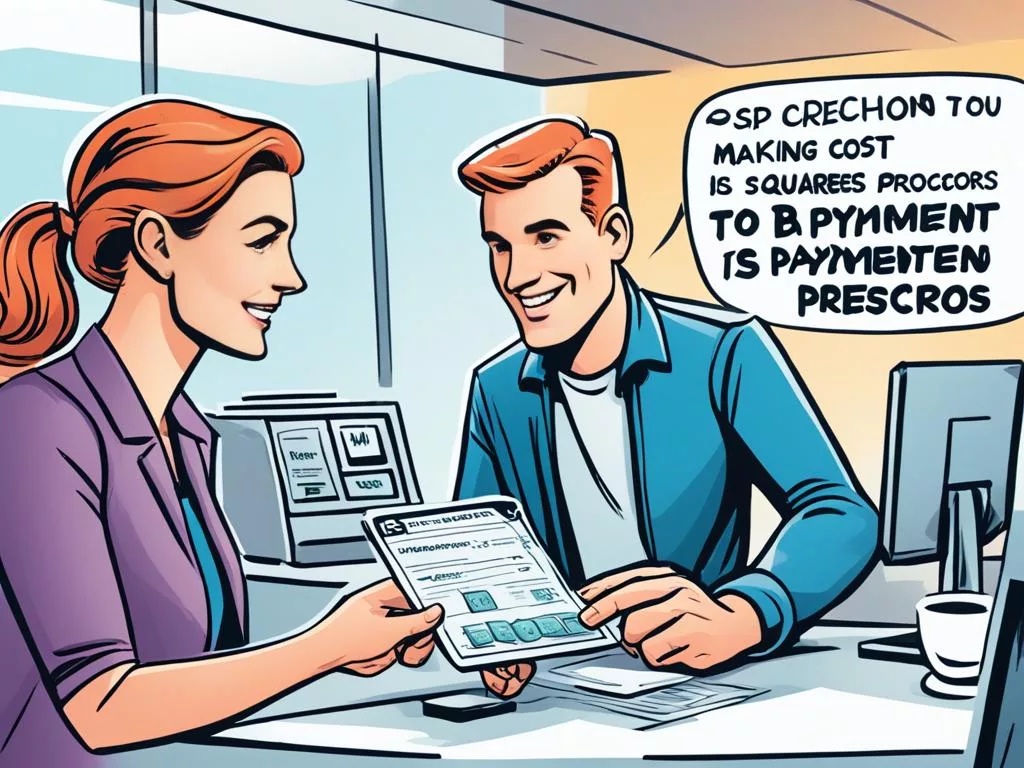Imagine a bustling shop at the heart of Main Street, its countertop gleaming under warm lights, and every customer’s transaction smooth, almost harmonious. As a small business owner, I know that feeling well, and how the right payment gateway for business can make or break that harmony. Choosing a payment processor is akin to selecting an invisible partner—one that amplifies your every success and keeps the rhythm of sales in flawless tempo.
In this dance of digits and dollars, the best payment processor is not just about rates; it’s about reliability, resonance with your clientele, and the subtle art of convenience. It’s the heart of countless transactions, whether you’re ringing up sales of heirloom tomatoes from your family farm or coding the next big app startup. Square’s swipe/chip transaction fees are a modest 2.6% plus 10 cents per transaction, a friendly tune for brick-and-mortar locations, while Stripe’s online mastery strikes with a 2.9% plus 30 cents per successful card charge1. For my fellow entrepreneurs caught in the whirlwind of comparing, the Stripe vs Square review is not just a decision—it’s a declaration of your business’s future.
Understanding the Basics of Payment Processing Services
As I delve into the intricacies of online payment comparison, it’s evident that robust business payment platforms like Stripe and Square are not just facilitators but pivotal components in the realm of payment processing services. These platforms serve as a conduit among businesses, consumers, and financial entities, ensuring that transactions are seamless occurrences rather than hurdles in commerce. Both Stripe, founded by two Irish entrepreneurs in 20102, and Square, launched a year earlier in 20092, have asserted their presence in this industry. They provide a plethora of payment methods, including all major credit cards, which is fundamental for maintaining the dynamic flow of today’s market.
| Feature | Square | Stripe |
|---|---|---|
| Founding Year | 2009 | 2010 |
| Focus | In-person businesses | Online transactions |
| Transaction Fees | 2.6% + $0.10 | 2.9% + $0.30 |
| Company Status | Public (Block) | Private |
| Software Integrations | 300+ | 550+ |
| Customer Support Hours | 24/7 | 24/7 |
| Invoicing Fees | Additional 0.4% for online card transactions on Free Plan | 0.4% or 0.5% on top of payment processing fees |
| ACH Payment Fees | Flat 1% fee (min $1) | 0.8% (up to $5 max) |
| Chargeback Fees | $15 per chargeback | No charge |
From the outset, my comparison unfolds a narrative where Square, rebranded as Block yet retaining its ticker symbol SQ2, champions the physical retail space with its adapters for mobile devices, POS systems, and a name that’s become synonymous with mobility for brick-and-mortar businesses2. Their transaction cost, at 2.6% plus a $0.10 fee per swipe2, appears tailored for businesses seeking cost-effective solutions without the burden of monthly fees or expensive equipment2. In the online sphere, Stripe’s dedication to online transactions shines, offering a vast array of integrations and slightly higher fees as a trade-off for reduced fraud risks2. The platform’s integration capabilities vastly outweigh that of Square, boasting over 550 to Square’s 3003, and cater to businesses whose operations are rooted in the digital domain.
Despite their differences, both companies have disrupted traditional payment processing services, rivaling the juggernauts that are the large banks2. They’ve established themselves as inclusive business payment platforms, with Square offering hardware for card-present transactions and Stripe addressing the online side with innovative solutions like Terminal, introduced in 20182. Customer support also stands as a definitive aspect, where both offer exceptional assistance, yet Stripe offers its services round-the-clock3.
I observe that businesses today yearn for adaptability and both Stripe and Square facilitate this with their direct deposit features, aligning with the business’s routine cycle2. This duality of convenience is exemplified with Square’s slight lead in in-person fee charges, 2.6% plus $0.10, contrasting with Stripe’s online rate of 2.9% plus $0.3023. Square, with a public persona2, and Stripe, retaining its privacy2, represent more than mere choices; they embody strategic pathways for businesses forecasting their presence both offline and online.

The shifting landscapes of business payment platforms demand a rigorous online payment comparison, blending a keen understanding of processing fees with customer experience enhancements. My aim as I wrap up this exploration is to acknowledge that Square and Stripe are more than competitors; they are essential architects in the intricate world of payment processing services. Their ongoing evolution and the features they provide will undoubtedly continue to shape how businesses engage with their clientele and manage the flow of commerce in an increasingly digitized economy.
Stripe vs Square: Core Differences and Similarities
As a merchant venturing into the digital marketplace, it’s imperative to choose an e-commerce payment solution that aligns with your business model. Two giants in this arena, Stripe and Square, offer robust payment gateways for business but cater to different needs. Analyzing their online payment comparison, we find that while both Stripe and Square were introduced within two years of each other—Stripe in 20114 and Square in 20094—their evolution has marked them as distinct entities in the commerce space.
Both platforms profess to democratize e-commerce payment solutions with no start-up fees4 and similar charges for basic online transactions, setting the rate at 2.9% plus 30 cents per transaction45. However, when examining in-person point-of-sale fees, Square offers a slightly more economical rate at 2.6% plus 10 cents45, a testament to its focus on physical storefronts and providing accessible POS solutions to entrepreneurs with varying levels of tech savvy.
Stripe shines with its developer-centered features, allowing meticulous customization for customer checkout experiences—a nod to their online commerce proclivity. This attention to technical detail is complemented by their wider range of supported payment types, from major credit cards to virtual wallets and direct bank transfers through ACH and SEPA Direct Debit4. Furthermore, Stripe’s ability to accept over 135 currencies positions it as a formidable payment gateway for business with a global outlook4.
Square doesn’t lag in performance either; its POS system, which starts at a lower price point for the card reader compared to Stripe’s offering4, signals its dedication to small businesses and entrepreneurs. Moreover, Square simplifies the challenge of chargebacks by imposing no fees for disputes4, a relief for many business owners.
Support services are another area of scrutiny. Stripe outpaces with round-the-clock phone, chat, and email assistance4, whereas Square extends 24/7 email support but limits its phone assistance to daylight hours4. This level of support reflects Stripe’s commitment to ensuring their payment solutions are seamless, irrespective of when or where they’re being utilized.
Yet, what it boils down to when choosing between Stripe and Square often hinges on the specific needs of your business. Stripe’s integration prowess and advanced payment options may serve well for the tech-driven e-shop, while Square’s user-friendly setup with lower in-person transaction fees could be the winning choice for the brick-and-mortar retailer.
| Stripe | Square | |
|---|---|---|
| Founded | 20114 | 20094 |
| Start-up Fees | None4 | None4 |
| Basic Online Transaction Fee | 2.9% + $0.3045 | 2.9% + $0.3045 |
| POS Transaction Fee | 2.7% + $0.0545 | 2.6% + $0.1045 |
| Payout Period | Within 2 working days4 | Within 1 business day4 |
| Payment Types Supported | Visa, Mastercard, AmEx, Discover, JCB, local methods, virtual wallets, SEPA, ACH4 | Major credit cards4 |
| Chargeback Fees | $15.00 USD4 | None4 |
| Customer Support | 24/7 phone, chat, email4 | 24/7 email, daytime phone4 |
| POS Card Reader Cost | Starts at $59.004 | Starts at $49.004 |
Ultimately, merchants must contemplate the unique aspects of their operations when evaluating these e-commerce payment solutions. The balance between technical flexibility and ease of use could very well tip the scales in favor of one platform over the other.

Evaluating Transaction Fees and Cost Implications
As I delve into the intricate world of payment processing services, a critical facet that I meticulously analyze is the fee structure, which often tips the scales when choosing a payment processor. Square’s pricing model is particularly appealing for businesses with monthly sales under $5,000, levying a swipe/chip transaction fee of 2.6% plus 10 cents61. In contrast, businesses with stable revenue surpassing this threshold may find Stripe’s fee uniformity across swipe/chip and keyed transactions at 2.9% plus 30 cents more predictable and manageable61. I also take into consideration the unique offerings of each platform; for example, Square does not charge for chargebacks, potentially saving businesses on unforeseen expenses, a benefit not overlooked when selecting a business payment platform1.
For international transactions, Stripe adds a 1% fee, an important consideration for businesses with a global customer base1. This contrasts starkly with Square, which does not penalize international sales, tipping the balance for companies serving an international market. Furthermore, Square’s philosophy of returning the original transaction fee for refunds positions it as a compassionate partner for businesses that often deal with returns1. In terms of keyed transactions, Square’s fees increase to 3.5% plus 15 cents, cautioning those businesses that enter card details manually to weigh the cost implications carefully6.
Stripe’s toolkit, favored by e-commerce and tech-centric firms, extends to accepting over 135 currencies, reinforcing its reputation as an advanced payment processing service for today’s borderless commerce1. Contrastingly, Square simplifies operations with its less customizable yet user-friendly system, complete with hardware options perfect for in-person transactions, a boon for retail stores and service providers1. Both Square and Stripe comfortably sit among the top 10 POS systems, yet they appeal to distinct market segments, underlining the importance of aligning a platform’s capabilities with business needs1.
When analyzing alternatives to Square and Stripe, industry players like Clover and Helcim surface, offering varied services that cater to the diverse tapestry of business payment requirements. It’s clear that understanding the nuanced transaction fees and related costs associated with these services is paramount for a business’s profitability and cash flow management. Square’s lack of startup fees, paired with its swift one to two business day funding time6, shows its commitment to facilitating businesses’ immediate financial needs. However, since Square operates as an aggregator through entities like Paymentech and JP Morgan Chase, it’s beneficial to consider how such partnerships might affect transaction processes in comparison to Stripe’s direct processing approach6.
| Feature | Square | Stripe |
|---|---|---|
| Swipe/Chip Transaction | 2.6% + 10¢6 | 2.9% + 30¢1 |
| Keyed Transaction | 3.5% + 15¢6 | 2.9% + 30¢1 |
| Chargeback Fee | None1 | 0.40%1 |
| International Transaction | None1 | 1% extra1 |
| Refund on Transaction Fees | Yes1 | No1 |
| Monthly Fee for Retail | $60 per location + $20/additional register6 | N/A |
| Monthly Fee for Restaurants | $60 per location + $40/additional register6 | N/A |
| Currency Support | N/A | Over 1351 |

Stripe vs Square: Which One is Best for Your Business?
When I’m tasked with choosing a payment processor for my business, the decision between Stripe vs Square is pivotal. I consider Stripe’s 24/7 customer support3 and an extensive range of over 550 software integrations3 ideal for when my operations extend globally and require flexibility across various software platforms. Their developer-centric features make Stripe a contender for my payment gateway for business when I prioritize online transactions. However, the absence of a monthly subscription fee is an enticing offering from Stripe that appeals to my budget-conscious mind.
In contrast, if my storefront demands a tangible interaction with customers, Square becomes incredibly relevant with its competitive in-person transaction rates of 2.6% plus $0.103 and diverse POS system options that cater to various physical settings3. Moreover, Square’s no-chargeback fee policy3 and the absence of fees for refunds, thanks to their free magstripe reader, make them a solid choice, proving that they understand the nuances of brick-and-mortar operations. Square’s customer support, although not round-the-clock, is generally sufficient for my business operations confined to standard working hours3.
Ultimately, when I pen down a Stripe vs Square review, I determine the superiority based on the specifics of my business transactions. Square seems to edge out as the best payment processor for businesses that require physical customer interactions and operate mainly during the day, whereas Stripe excels in the e-commerce sphere3. I weigh my options, thinking about the volume of transactions, software needs, and customer interaction hours before making the final selection. The verdict hinges on my business model, and yours should too. As you go about choosing a payment processor, consider these nuances to ensure that your business thrives with the payment partner that aligns with your transactional lifestyle and customer demands.
Source Links
- https://www.forbes.com/advisor/business/software/square-vs-stripe/
- https://www.investopedia.com/articles/personal-finance/021715/square-vs-stripe.asp
- https://www.usatoday.com/money/blueprint/business/credit-card-processing/stripe-vs-square/
- https://www.tipsandtricks-hq.com/stripe-vs-square-11411
- https://apiexperts.io/blog/stripe-vs-square-comparison/
- https://www.cardfellow.com/blog/square-review-rates-fees/

